Trekking Pole Tents Explained
And The Top 6 For 2020
For people who want ultralight, functional shelters, trekking pole tents very popular right now. That makes a lot of sense, because one key to hiking light is making sure your gear is multi-use. If you’re bringing trekking poles anyway, why not use them as the structure for your tent?
Trekking poles are height adjustable and often sturdier than increasingly flimsy ultralight tent poles (plus they give your tent that “I-know-what-I’m doing” look). I’ve made up a list of the best trekking pole tents on the market in 2020, but first I’ll go over what exactly a trekking pole tent is and how it works.
If you already know all about them and just want my picks, you can jump to it here.
What is a Trekking Pole Tent?
A trekking pole tent is simply a tent that uses trekking poles to create the structure that holds it up. As opposed to using those bulky curved, multi-piece tent poles for structure, this can save a ton of weight and space. Trekking pole tents are very different from their all-in-one counterparts, though. There are a few things to consider when deciding on a trekking pole tent vs. a traditional tent that go beyond weight savings.
Freestanding Vs. NonFreestanding
Freestanding tents are tents that don’t require any stakes to set up. They’re the classic dome-shaped camping or backpacking tent where you bend long, crisscrossing poles into the shape of a tent.
One big advantage is that you can literally pick them up and move them if you picked a bad spot, and they’re pretty much impossible to mess up. They make great beginner tents and are just great in general for people who value ease-of-use over minimizing weight. These always require the extra weight of poles, though, and often still require stakes for full functionality (i.e. staking out vestibules).
Non-freestanding tents are tents which require poles and stakes together to set up and use properly. The most common type you’ll see is basically an A-frame, where two trekking poles hold up the center while tent stakes at the head and feet put tension on the fly (pyramids can be even lighter, but a little less user friendly). This set-up is light and fast (often faster to set up in reality than freestanding tents), but there are a few notable drawbacks:
- Require careful spot selection
- Can’t be pitched everywhere (like on flat rocks)
- Trekking poles can break while hiking with them, leaving you down a tent pole
- Can be less sturdy, depending on structure (see TT’s Stratospire for an awesome counterexample)
- Often won’t shed snow as well
For many, the weight savings more than offset these drawbacks. But when you’re spending $300+ on a tent, you need to know what you’re working with. Which brings me to my second point about trekking pole tents…
Single wall vs. Double wall
Head over to the r/ultralight subreddit or backpacking light forums and you’ll see endless debates about the virtues of single wall vs. double wall tents. I love talking gear (and I have no problem participating in conversations of tent-philosophy), but a lot of those discussions come down to splitting hairs on individual tents. Here’s what you need to know about how the words double-wall and single-wall play into trekking pole tents (or tents of any kind).
Double walls are what you find on the vast majority of freestanding tents. They have two layers; an inner layer (most often a bug mesh upper with a waterproof bathtub floor) and an outer layer (the rainfly). This layering makes the tents modular (often the inner and outer layers can be set up independently) and can help manage condensation.
Single walls are tents where the whole tent is made of only one layer of waterproof material. These are the simplest and lightest tents available, but they have no modularity; it’s all or nothing. The other commonly reported problem with them is condensation.
A note on condensation
Condensation is when you get water droplets forming on the inside of your tent. You can get wet by brushing up against it, and if severe enough it can end up dripping down and soaking you while you sleep. It’s unavoidable, but how bad it is can be affected by a variety of factors. The reality of it is though, that with all conditions equal, double-wall and single-wall tents will have the exact same amount of interior condensation.
I think it’s kind of a common misconception that double wall tents somehow prevent condensation. The only real difference between double and single walls in this regard is that in a double wall tent you’re less likely to brush up against the wet tent walls because of the mesh layer in between. It can still drip down on you in the middle of the night just as bad as in a single wall tent. The only way to actually manage condensation is to understand why condensation happens in the first place and choose your campsites accordingly.
As trekking pole tents are usually pretty ultralight in style, many are single wall to save weight. Some double wall options are still super light, though, and the added modularity can be great (see TT Stratospire again for a lesson in modularity). You’ll have to weigh out the pros and cons for yourself, but I have included some of each in this list.
Top 6 Trekking Pole Tents For 2020
For the purposes of this list, I’m being kind of narrow on my definition of “trekking pole tent.” It’s semantics, really, but I think having the word “tent” in there suggests something fully enclosed and reasonably user friendly (the alternative would be a "shelter" or "tarp"). For this reason I’m not including tarp/pyramid shelters like the MLD Duomid or HMG Ultamid. They have their place, but that’s for a different post.
Without further ado, here are my top picks.
*(All specs listed are for the 2-person version without poles or stakes)*
1. Zpacks Duplex (solo version: Plexamid)
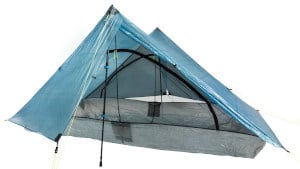
Packed Weight: 19.4 oz
Floor Area/Dimensions: 45" x 7.5ft
Vestibule Area/Dimensions: 20.75" deep each side
Peak Height: 48"
Doors: 2
Walls: Single wall
Material: DCF
MSRP: $599 USD
At this point the Duplex is pretty much the de facto king of trekking pole tents. It has been trail tested on hundreds of thousands of miles and in every condition imaginable and came back with generally stellar reviews. It's also the lightest on this list. The use of DCF makes it a spendy option, but you get what you pay for. I can’t really say anything about it that hasn’t been said, just know that it’s one of the best.
Best for: People who want the lightest tent possible
2. TT stratospire 2/stratospire li(DCF version)
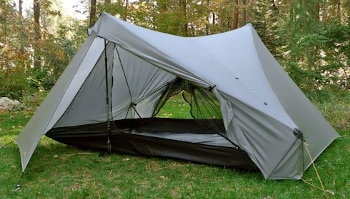
Packed Weight: 44 oz (Stratospire Li: 28oz)
Floor Area/Dimensions: 52" x 86" (31 sq ft.)
Vestibule Area/Dimensions: Not listed, but definitely on the large side
Peak Height: 50"
Doors: 2
Walls: Double wall
Material: Silnylon or DCF
MSRP: $359 USD (Li: $689) USD
If there’s one person I trust over all others to put the best knowledge of fabrics, geometry, and usability together, it’s Henry Shires from Tarptent (he won me over on this episode of Backpacking Light Podcast). He's has been in the ultralight game for a long time and the Stratospire is the culmination of years of innovation. The geometry is a work of art, and I especially love that the setup is fly-first. This means that you can set up the fly and clip the inner mesh into it without any risk of getting the interior wet. It also has the option to add “sidecars” to the vestibules, which are essentially extra mesh interiors that give you more sleeping space for little ones (for some, kids; in our case, dogs). This is also one of the few tents on this list for which there is a regular silnylon and a DCF version (note that the dimensions for the DCF version are slightly different).
Note: Tarptent does make a Stratospire 1, but it's best application would be mostly as a 4-season solo shelter. If you want a great solo 3-season tent with the TT philosophy, check out the Notch and Notch Li.
Best for: Couples with kids/dogs, tall people, people looking for a 3-4 season crossover tent
3. GG The Two (Solo Version: The One)
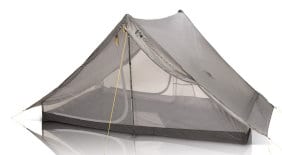
Packed Weight: 29 oz
Floor Area/Dimensions: 52" at the head and 42" at the foot x 89" long (29 sq ft.)
Vestibule Area/Dimensions: 35" deep each sid (32.4 sq ft total)
Peak Height: 46"
Doors: 2
Walls: Single Wall
Material: Silnylon
MSRP: $375 USD
Gossamer Gear is another company that I generally love, and these tents are no exception to the rule. They are a bit on the fragile side (15 denier nylon for the canopy and floor) but at under 2 pounds for a two person tent that’s to be expected. One of the big highlights of this tent is the gear storage; the vestibules are massive, there are internal gear pockets, and there’s an optional clothesline for drying out wet clothes.
If you're okay being more careful with it, this is the lightest tent on this list for the price (while still being decently roomy).
Best for: People who value a high space to weight ratio
4. REI Co-op Flash Air Two (Solo Version: Flash Air One)
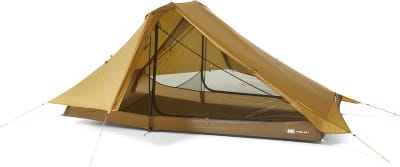
Packed Weight: 37 oz
Floor Area/Dimensions: 52" at the head and 42" at the foot x 88" long (31.7 sq ft.)
Vestibule Area/Dimensions: 16.8 sq. ft.
Peak Height: 42"
Doors: 2
Walls: Single Wall
Material: Silnylon
MSRP: $299 USD
I love REI, so it’s cool to see them really getting into the ultralight tent game. This is a brand new tent for 2020 so I’m sure there are some bugs to work out in future models, but reviews look great so far. One thing that sets this apart from other options are the sturdy plastic hubs that attach to a pole that crosses the top. This keeps the top of the tent from sagging like many other A-frame models and gives you more headroom bang for the buck. There are also foot poles to increase toeroom and ventilation.
The 15d nylon requires care when using, but overall this looks like a great tent, especially for the price.
Best for: People who need a good value
5. Six Moon Designs Lunar Duo (Solo version: Lunar Solo)
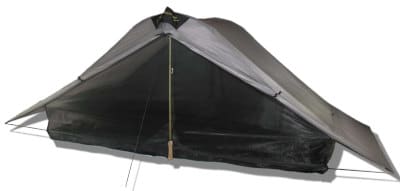
Packed Weight: 45 oz
Floor Area/Dimensions: 54" x 90" (34 sq ft.)
Vestibule Area/Dimensions: 24 sq. ft. total
Peak Height: 45"
Doors: 2
Walls: Single Wall
Material: 30D Silnylon
MSRP: $375 USD
The Lunar Duo is on the heavy side of ultralight tents, but what it sacrifices in weight it makes up for in livable space. It has the biggest floor area of any tent on this list and a decent peak height, making it great for people who want their two person tent to actually be really comfortable for two people. It could also be good for people with little kids or dogs.
Another plus with this tent is the 30D fabrics. It contributes to the weight, but is significantly more durable than the lighter fabrics found in most of these tents. If you're hard on gear (like we are), this might be the tent for you.
Best for: People who value lots of space
6. Tarptent Motrail (Solo Version: Protrail)
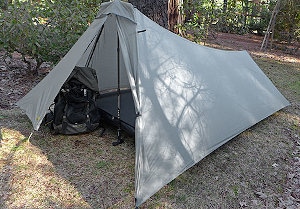
Packed Weight: 34 oz
Floor Area/Dimensions: 52" x 84" (30 sq ft.)
Vestibule Area/Dimensions: 12 sq. ft. (only one vestibule)
Peak Height: 47"
Doors: 1
Walls: Single Wall
Material: 30D Silnylon
MSRP: $265 USD
This list wouldn't be complete without another offering from Tarptent. The Motrail is lighter and more minimalist than the relatively large Stratospire, with single wall construction and one big front entrance rather than one on each side.
The reduced weight (without much sacrifice in livable space) is great, and at $265 this is the most budget friendly option on the list by far. It also can be set-up with only one pole if necessary, which is nice for those plan on using it solo and want some insurance against a pole breaking. It's no frills, but it's still a great, durable, tent for a great price.
Best for: People on a budget, people who value durability
That's my list! You might be thinking "there are some good options out there that didn't make the cut! what about them?". I kept this list to 6 because I didn't want to be too redundant with my picks (structure, price, style, etc.), and I wanted to only provide the absolute best tents out there.
If you feel like I should have included something else (or shouldn't have included something I did) I'd love to hear about it in the comments below.
